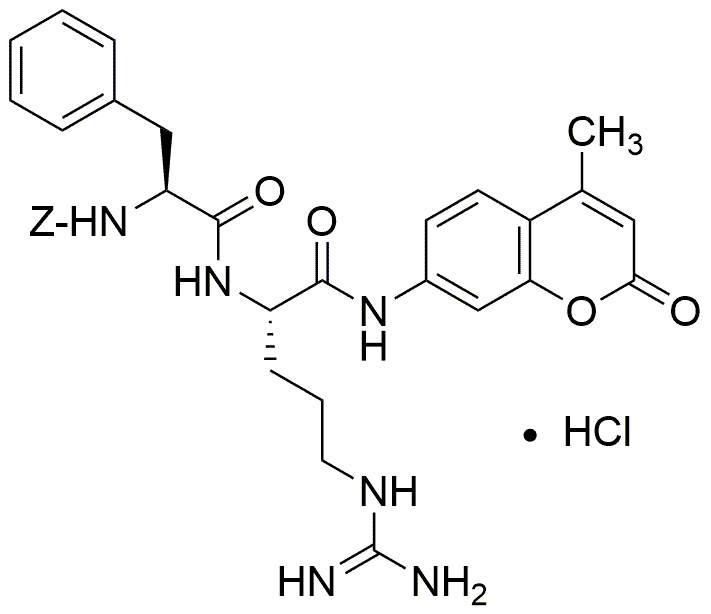Z-Phe-Arg-AMC·HCl is widely utilized in research focused on:
- Protease Activity Assays: This compound serves as a substrate in assays to measure protease activity, which is crucial for understanding various biological processes and disease mechanisms.
- Drug Development: Its ability to mimic peptide bonds makes it valuable in the pharmaceutical industry for developing new drugs targeting proteolytic enzymes, enhancing therapeutic efficacy.
- Biochemical Research: Researchers use it to study enzyme kinetics and inhibition, providing insights into enzyme function and potential therapeutic targets.
- Diagnostics: The compound can be employed in diagnostic assays to detect specific proteases related to diseases, aiding in early diagnosis and treatment strategies.
- Biotechnology: In biotechnology, it is used in the production of recombinant proteins, facilitating the study of protein interactions and functions in various applications.
General Information
Properties
Safety and Regulations
Applications
Z-Phe-Arg-AMC·HCl is widely utilized in research focused on:
- Protease Activity Assays: This compound serves as a substrate in assays to measure protease activity, which is crucial for understanding various biological processes and disease mechanisms.
- Drug Development: Its ability to mimic peptide bonds makes it valuable in the pharmaceutical industry for developing new drugs targeting proteolytic enzymes, enhancing therapeutic efficacy.
- Biochemical Research: Researchers use it to study enzyme kinetics and inhibition, providing insights into enzyme function and potential therapeutic targets.
- Diagnostics: The compound can be employed in diagnostic assays to detect specific proteases related to diseases, aiding in early diagnosis and treatment strategies.
- Biotechnology: In biotechnology, it is used in the production of recombinant proteins, facilitating the study of protein interactions and functions in various applications.
Documents
Safety Data Sheets (SDS)
The SDS provides comprehensive safety information on handling, storage, and disposal of the product.
Product Specification (PS)
The PS provides a comprehensive breakdown of the product’s properties, including chemical composition, physical state, purity, and storage requirements. It also details acceptable quality ranges and the product's intended applications.
Certificates of Analysis (COA)
Search for Certificates of Analysis (COA) by entering the products Lot Number. Lot and Batch Numbers can be found on a product’s label following the words ‘Lot’ or ‘Batch’.
*Catalog Number
*Lot Number
Certificates Of Origin (COO)
This COO confirms the country where the product was manufactured, and also details the materials and components used in it and whether it is derived from natural, synthetic, or other specific sources. This certificate may be required for customs, trade, and regulatory compliance.
*Catalog Number
*Lot Number
Safety Data Sheets (SDS)
The SDS provides comprehensive safety information on handling, storage, and disposal of the product.
DownloadProduct Specification (PS)
The PS provides a comprehensive breakdown of the product’s properties, including chemical composition, physical state, purity, and storage requirements. It also details acceptable quality ranges and the product's intended applications.
DownloadCertificates of Analysis (COA)
Search for Certificates of Analysis (COA) by entering the products Lot Number. Lot and Batch Numbers can be found on a product’s label following the words ‘Lot’ or ‘Batch’.
*Catalog Number
*Lot Number
Certificates Of Origin (COO)
This COO confirms the country where the product was manufactured, and also details the materials and components used in it and whether it is derived from natural, synthetic, or other specific sources. This certificate may be required for customs, trade, and regulatory compliance.


